| Article ID | Journal | Published Year | Pages | File Type |
|---|---|---|---|---|
| 974411 | Physica A: Statistical Mechanics and its Applications | 2015 | 8 Pages |
•Different type coupled-networks are more vulnerable than the same type coupled-networks.•If only lowly connected nodes were attacked, the system can still leads to a first order percolation phase transition.•Different type coupled-networks are difficult to defend by strategies such as protecting the high degree nodes.•If only the highly connected nodes were attacked, coupled scale free networks become more vulnerable than the others.
Modern systems are mostly coupled together. Therefore, they should be modeled as interdependent networks. In this paper, the robustness of interdependent networks coupled with different type networks is studied in detail under both targeted and random attack. The critical fraction of nodes leading to a complete fragmentation of two interdependent networks is analyzed. Some findings are summarized as: (i) For random attack problem, the existence criteria for the giant component in interdependent networks coupled by two different type networks are quite different from those coupled by the same type networks. Different type coupled networks are more vulnerable than the same type coupled-networks. (ii) For targeted attack problem, if the highly connected nodes are protected and only the lowly connected nodes failed, the system leads to a first order percolation phase transition for different type coupled-networks, and a second transition for same type coupled-networks as well. The available result implies that different type coupled-networks are difficult to defend by strategies such as protecting the high degree nodes that can be useful to significantly improve robustness of the same type coupled-networks. (iii) For targeted attack problem, when the lowly connected nodes are protected and only the highly connected nodes failed, coupled scale free networks become more vulnerable than the others.
